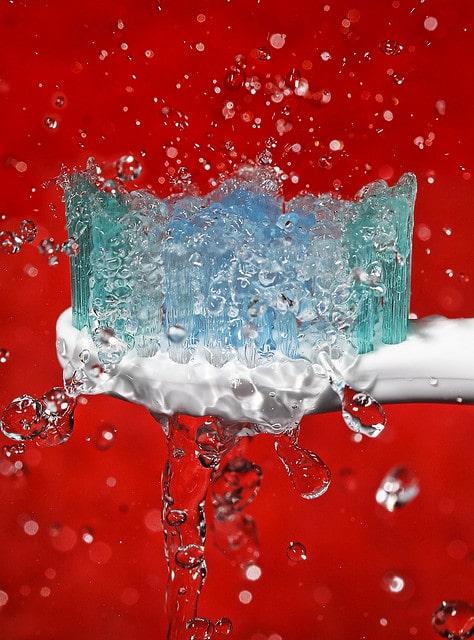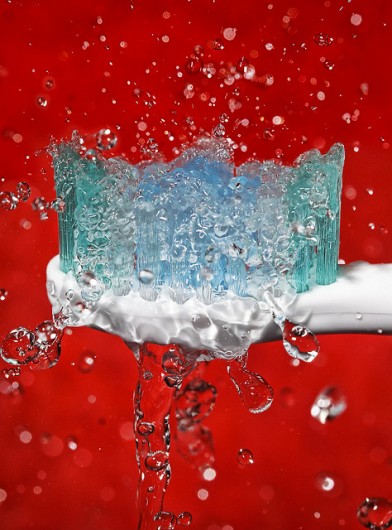
Preventing caries (cavities) in fluoride-free families
- 4 ways your child may not tolerate cow’s dairy: allergy, milk protein sensitivity, cerebral folate deficiency, and lactose intolerance - January 3, 2024
- 5-hydroxytryptophan (5-HTP) and the “feel good” neurotransmitter serotonin - October 4, 2023
- Quercetin supplementation for children: research, safety and efficacy - May 13, 2023

Last week I talked a little about the pros and cons of giving fluoride supplements to your kids. This week I want to write a little bit about fluoride-free ways to prevent cavities (or “caries” as we say in the medical/dental world).
So first I want to say that there really is no excuse for having poor oral hygiene habits – especially if you decide to go fluoride-free. I hate to say it, but I have seen several families who have decided against fluoride but then neglected brushing and flossing and ended up with a child with a mouthful of cavities. Please don’t go there. Remember that sometimes the “natural” route is also the time-consuming route. (And, in my opinion – the more rewarding route!) It is definitely possible prevent cavities and strengthen enamel, but it takes time and diligence.
Oral hygiene means…?
Good oral hygiene means you are helping your baby/toddler/child brush AND FLOSS every day. As my Missoula Pediatric Dentist friends reminded me: flossing should occur anytime two teeth are touching. In other words: whenever your child has more than one tooth! A good pediatric dentist will be able to show you how to floss your wiggly toddler – they may not like it (but hey, they don’t like eating vegetables, and you still have them do that, right?).
Dietary changes
Diet plays a huge role in the formation of caries. Most parents have had the “no bottle to bed” rule drilled into them – but many parents forget about other causes as well. Remember that caries are caused by bacteria (primarily Streptococcus mutans) which secrete acid and thereby breakdown enamel leading to caries. Anything that feeds bacteria can potentially lead to caries.
Juice is a no-no in my book.
Somewhere there is a brilliant (but exceedingly misleading) advertising director who started the whole “one cup of juice is equal to 2 servings of fruit” thing. I’m sorry, but this just isn’t true. Juice essentially takes all the good things out of the fruit (the antioxidant-rich skin as well as fibrous pulp) and basically just leaves sugar. Sugar, in case you missed the memo, isn’t so good for you. It leads to insulin resistance (diabetes), obesity, inflammation and more. Save juice for those really special occasions when it needs to be “special.”
Please do not give your child diet sodas as a replacement for juice. First because many artificial sweeteners are actually carcinogenic. Second because artificial sweeteners may trick your taste buds but they don’t trick your brain – your brain is still hungry for glucose, and will increase rather than decrease sugar cravings until it gets what it wants. Water or herbal tea are great replacements for juice. Milk or milk substitutes are also good alternatives, but should be limited to 2-3 servings per day at the most (they have a tendency to inhibit iron absorption which leads to iron deficiency anemia).
Other cavity-forming foods include sticky sweets like raisins and fruit rolls. The main thing to remember is to limit these sweets to mealtimes (snacking increases caries) and make sure your child rinses his/her mouth afterwards.
For some families who are really prone to caries I recommend trying a grain-free (or low-grain) diet like the GAPS, Paleo, Fodmaps or SCD diets. These diets severely limit the starches and sugars that Streptococcus mutans feeds off of. Most of these diets are actually designed for intestinal dysbiosis or SIBO (small intestinal bowel overgrowth). Patients who are chronic cavity-formers or have periodontitis seem to be more apt to have these intestinal dysfunctions. In fact, new research is starting to show the link between oral dysbiosis and these dental diseases. I highly recommend testing for intestinal dysbiosis or SIBO if your family continues to have caries or periodontitis. I also recommend testing for celiac disease for really early cavity-formers – I don’t have any research behind this one, but it was recommended to me by a celiac expert who has found early caries to be a risk factor for the disease.
Breastfeeding is 100% protective, right?
Another common misconception is that breastfeeding is completely protective, and doesn’t “count” toward creating cavities, even when nursing frequently at night. This is only true before the introduction of solid foods (containing sugars, starches or grains). So once solid foods are introduced the breastmilk mixes with the residual sugars left over after eating, creating the perfect environment for bacteria to thrive and cause cavities.
Many parents have complained to me that their dentists discouraged breastfeeding. Hopefully this is not the case! Breastfeeding provides essential nutrients (including easily absorbable forms of calcium) that aid in the formation of strong enamel. BUT breastfeeding all night long after the introduction of solid foods is really not a great idea. (First because of the cavities, secondly because poor Mom and Dad aren’t getting any sleep at all.)
Okay co-sleeping Moms and Dads – hear me out! (Did I lose some of you already?) I am not saying not to breastfeed, or not to breastfeed on demand, if that is what you choose. If you do nurse frequently at night you must make sure to thoroughly brush and floss your baby’s teeth before going to bed.
Research says….
So what else can we do besides dietary changes? Perhaps surprisingly, we do have quite a bit of research on some natural methods of prevention. I’ll be going through these one-by-one, starting with the strongest research (and ending with the anecdotal).
Xylitol
Xylitol, sorbitol and erythritol are all sugar alcohols. Sugar alcohols taste sweet, just like sugar, but they have a fraction of the calories as normal sugar. (By the way, they are not “alcoholic” – sugar alcohols are named as such because they have extra –OH groups attached to the carbon chain. This OH group is called a “hydroxyl” group. Anytime an -OH group is attached to a carbon we call it an “alcohol.”)
Xylitol helps protect teeth because it is non-fermentable by bacteria. Oral bacteria tend to “starve” in the presence of xylitol which eliminates oral dysbiosis. Xylitol can be taken in the form of oral lozenges, syrup, gum or mixed with toothpaste or mouthwash.
The research isn’t perfect on xylitol, with some studies showing it is significantly less effective than fluoride. Nevertheless, I did find some research that shows xylitol significantly reduces Streptococcus mutans in the mouth. There also appears to be some research that xylitol can induce remineralization of the teeth (that is pretty cool!).
Remember, though, xylitol is not the best for people with sensitive tummies. My GAPS, SCD or Fodmaps diet patients tend to not do well with xylitol (as well as sorbitol and erythritol) – ditto for people with irritable bowel syndrome, Crohn’s disease or Ulcerative colitis. Use with caution!
Cranberry
We usually think of cranberry juice for urinary tract infections – but in fact the same mechanism of action applies for eliminating bacteria in the mouth. The main constituent responsible for this “anti-bacterial” effect are the proanthocyanidins. In fact, cranberry isn’t directly anti-bacterial – it actually inhibits the binding of the bacteria to the mucous membranes. Cranberry proanthocyanidins have been shown to decrease biofilm accumulation.
But here’s the problem: cranberry juice has sugar! One study did show an effect even with cranberry juice (not just the concentrated capsules), with a 40-85% inhibition of bacterial growth. (That is pretty cool!) This effect only happens when you use pure cranberry juice, not cranberry mixed with apple or grape juice. Make sure to check that you are using organic cranberry juice, unsweetened. You can dilute it with a little water (to make it less tart) and sweeten it with xylitol if necessary.
Oil pulling
Oil pulling is essentially just rinsing the mouth with oil by “pulling” it through the teeth repeatedly. The tradition of oil pulling comes from Ayurvedic medicine (the traditional medicine in India).
There is actually quite a bit of research on oil pulling! Here is a randomized-placebo-controlled trial of oil pulling that compared chlorhexidine mouthwash to oil pulling – both groups had very similar reductions in total amounts of oral bacteria. (Chlorhexidine is a super strong synthetic antimicrobial, so that is pretty impressive!) Another study showed similar improvements of oil pulling in comparison to chlorhexidine – though it took 1-2 weeks to see the full effect.
Another note: though many people (in the internet world) recommend using coconut oil – I couldn’t find any research to support that. Most of the research supports the use of sesame oil which is traditionally used for oil pulling in Ayurvedic medicine. (You can find a decent sesame oil here)
…and others
Now we get to the anecdotal section of this post. There are a huge number of Weston A. Price fans out there who have noted improvement in their children’s caries by implementing dietary and supplemental changes recommended by the Weston A. Price foundation. (Weston A. Price was a dentist who studied traditional societies and noted that there are very few dental caries in developed countries that use traditional diets.)
There is a LOT to say about the Weston A. Price foundation recommendations. Some of it, in my opinion, is excellent, but some of it is not so good. I’ll try to devote an entire blog post to the subject of cod liver oil (and fermented cod liver oil, which is highly touted by the WAP).
The bottom line for this post is that there is very little data on dental caries and some of those recommendations. In fact, there is no research at all on fermented cod liver oil, or even regular cod liver oil for dental caries. Obviously it makes sense to give high vitamin D and vitamin K2 containing foods to strengthen enamel (in addition to calcium, magnesium, boron and strontium) – there is good data that those vitamins and minerals help in the ossification of bones. This is likely true for teeth as well.
There are likewise many anecdotal reports of success using homemade “remineralizing” toothpastes (containing calcium, magnesium and a variety of other natural substances). There is absolutely no data to support (or refute) this either. I think it is highly unlikely the tooth will significantly absorb any amount of topical minerals. But I don’t think it is harmful, so if your family has an extra afternoon to get a little messy – and you don’t mind greasy toothpaste – feel free to try those out as well. If your child’s caries worsen, then please switch back to “normal” toothpaste. The Missoula Pediatric Dentristry dentists highly recommend Tom’s of Maine Silly Strawberry toothpaste. (Yum!)








Ronnie
November 14, 2013 at 10:55 amNice post!
Phyllis Brumm
December 4, 2013 at 8:45 amI’m puzzled by your strong affirmation of fluoride’s dental benefits (topical fluoride may be an exception). What about the following:
End Fluoridation, Say 600 Physicians, Dentists, Scientists And Environmentalists
Article Date: 10 Aug 2007
http://www.medicalnewstoday.com/articles/79326.php
Recent peer-reviewed publications about Fluoride
September 27th, 2007
http://dremilykane.com/2007/09/27/recent-peer-reviewed-publications-about-fluoride/#more-109
This Food Blasts Your Body With Up to 180 Times the Fluoride in Drinking Water
Posted By Dr. Mercola | February 04 2012
http://articles.mercola.com/sites/articles/archive/2012/02/04/jeff-green-on-fluoride-toxins-part-2.aspx
Story at-a-glance
One of the primary sources of fluoride exposure is not fluoridated drinking water but non-organic foods, due to the high amounts of fluoride-based pesticide residues on these foods. Non-organic foods may account for as much as one-third of the average person’s fluoride exposure
Foods particularly high in fluoride include non-organic fresh produce, breakfast cereals, juices (particularly grape juice), deboned meats such as lunch meats, and black- or green tea (even if organic)
Fluoride has the ability to affect other chemicals and heavy metals; in some cases making them even more harmful than they would be on their own. For example, when you combine chloramines with the hydrofluorosilicic acid added to the water supply, they become very effective at extracting lead from old plumbing systems, promoting the accumulation of lead in the water supply
Studies have shown that hydrofluorosilicic acid increases lead accumulation in bone, teeth, and other calcium-rich tissues. This is because the free fluoride ion acts as a transport of heavy metals, allowing them to enter into areas of your body they normally would not be able to go, such as into your brain.
Langmuir, 2010, 26 (24), pp 18750€18759
Elemental Depth Profiling of Fluoridated Hydroxyapatite: Saving Your Dentition by the Skin of Your Teeth?
Frank Mller, Christian Zeitz, Hubert Mantz, et al.
http://pubs.acs.org/stoken/presspac/presspac/full/10.1021/la102325e
“Therefore, it has to be asked whether such narrow Ca(OH)2 and FAp layers really can act as protective layers for the enamel.”
http://www.tldp.com/fluoride.htm
http://all-natural.com/fleffect.html
http://articles.mercola.com/sites/articles/archive/2011/08/09/fluoride-and-pineal-gland.aspx
Dr. Erika Krumbeck
December 4, 2013 at 9:11 amHi Phyllis,
Did you read my original post about fluoride? It lists the pros and cons to taking internal fluoride supplements (including the risk of injury to the developing neurons). This post is about preventing caries in fluoride-free families! I’m not sure where you got “my strong affirmation of fluoride supplements” from – I never say that I advocate taking fluoride supplements – I do, however, want parents to be aware that they need to really be on top of their child’s oral hygiene, especially if they refuse fluoride supplementation. I still have yet to see the study that shows that internal fluoride supplementation actually increases the strength of the developing enamel – my dentist friends assure me that the study exists, but I have yet to see it. All the research I have found does support topical fluoride – and I think the risk of neurological injury compared to the benefit in reducing tooth caries supports topical use (except in children and adults with fluoride hypersensitivity, of course).
I hope this makes sense!
Dr. Erika
colleen
February 10, 2014 at 9:25 pmnot so much sense, if you had read the sites that Phyllis gave you, instead of banking on your dental school data, you would be telling a different story about fluoride – natural fluoride is present in whole foods and other
than that, fluoride is toxic waste that should never be near a human or any other living species.
extinctioners
May 1, 2014 at 11:26 pmextinctioners
Preventing caries (cavities) in fluoride-free families – Montana Whole Health
Megan
February 1, 2015 at 10:48 pmAre there any alternatives to xylitol that stop oral bacteria from sticking to teeth and multiplying? I have been using it but it could be whats effecting my IBS. Also, I’ve been using coconut oil for oil pulling and I’m not sure I’ve seen any differences. Its possible my gut issues are contributing but maybe sesame oil would be better. Thank you.